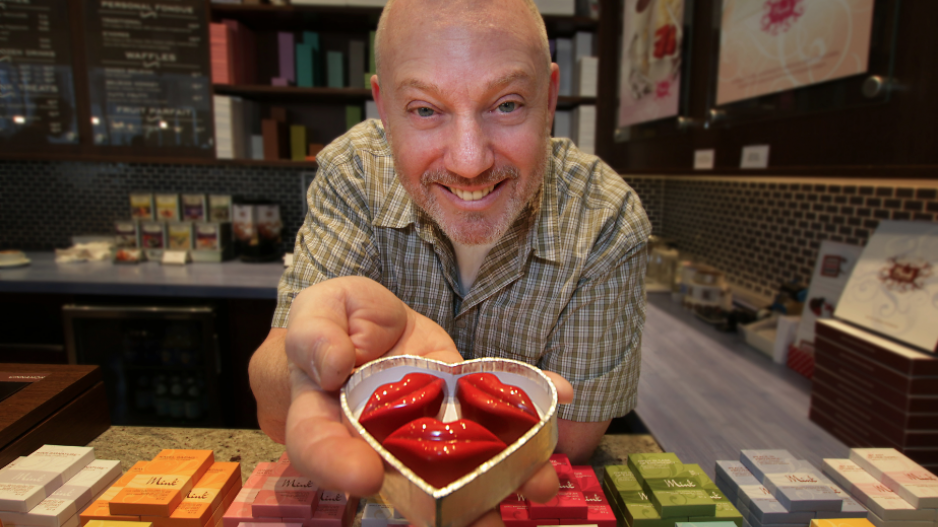He might be thinking about it, but Marc Lieberman won’t begin selling Valentine’s Day until this weekend.
With just a few days left before February 14, the president and founder of Vancouver-based Mink Chocolates will start rolling out Romeo and Juliet chocolate bars, mojito ganache hearts, salted caramel lovebird bonbons and champagne chocolate lips to love-struck customers.
The brand’s downtown location will be stocked with 10% to 12% more goodies than this time last year, and Lieberman expects to sell out.
“Valentine’s is probably the biggest chocolate holiday of the year,” he said. “The 14th is a gong show, the day before is a gong show and the day before that is a gong show.”
Even though preferences for sweets vary year to year, giving chocolates for Valentine’s Day gifts never goes out of style, and that means big business for local chocolatiers ranging from Purdys Chocolates to smaller operations like Mink. Overall, Lieberman estimates sales of Valentine’s chocolate are eight to nine times the volume on any given day.
“I have people that will beg to buy the samples that have been in the display case for three weeks, that I wouldn’t sell to anyone, because you just don’t do that,” he laughed. “They leave it to the last minute, and it truly is a sense of desperation.”
Because of both the desperate and the prepared, February 14 generates millions annually for restaurants, retailers, florists and jewellers in Canada.
The National Retail Federation estimates that American consumers will spend US$18.2 billion this year on Valentine’s Day. Last year, spending hit a record US$19.7 billion. In 2014, Canadian sales of items including wine, jewelry and lingerie fetched around US$10.3 billion for the entire year; Americans spent US$17.2 billion on Valentine’s Day alone.
Still, Valentine’s Day generates a windfall for local businesses in certain industries.
Rob Cameron, chief product officer at payment processor Moneris Solutions Corp., said Valentine’s Day week in Canada typically sees triple-digit spending growth at chocolate, candy and sweet shops and at florists, compared with the week prior. On February 14, 2013, for example, Canadian flower sales spiked 363% compared with sales on February 7.
Given the popularity and romance of roses, the increased spending boosts business for importers – who brought $70.9 million worth of cut roses and rosebuds into the country in 2014, according to Statistics Canada.
“Our import volumes go up significantly in our wholesale business in February,” said United Flower Growers CEO Bob Pringle. “They would almost double.”
Because roses are primarily imported from South America, local growers’ sales volume around February 14 fails to match the numbers seen around Mother’s Day.
“It’s darker, colder and more difficult especially for Canadian growers to grow, so there are increases in volume,” said Pringle, “but it’s limited by the growers’ capacity and the growing conditions that we have at this time of year.”
Each week, United Flower Growers sells locally grown products in three separate auctions. Last year, February’s first two weeks of auctions generated $1.5 million in sales for local producers. The first half of May, by comparison, brought in $2.1 million.
Restaurants are also busier on Mother’s Day, according to Ian Tostenson, president and CEO of the BC Restaurant and Food Services Association.
But Valentine’s Day is still good for business, especially when it falls on an otherwise slow night.
“On a Tuesday, it’s great. Because you are going to get more incremental diners,” Tostenson said. “Most restaurants see about a 30% to 45% increase in business because of Valentine’s over a typical night. So that’s big.”
According to OpenTable data, seated restaurant reservations in Canada were 174% higher on February 14, 2015, compared with the Saturdays before and after the special day. Eighty-six per cent of seated reservations were for couples, and 45% of reservations were made in the week leading up to the day.
“Canadians spend quite a bit of money on Valentine’s Day each year,” said JoAndrea Hoegg, an associate professor in marketing and behavioural science at the University of British Columbia’s Sauder School of Business. “Men tend to spend more than women, but they spend quite a lot, and it is big business, particularly in what you would imagine are the classic industries – the flower industry and the chocolate industry and the lingerie industry.”
Hoegg added that Canadians on average spend $150 for Valentine’s Day. She also noted a trend toward more experiential gift giving, which she said is backed by research that shows experiential purchases can be more satisfying than material gift buying.
“I think people believe that … we spend a little bit too much time and too much money on what some people would view is a fairly commercial holiday. I think people talk about spending less each year. In terms of what actually happens, I don’t think there’s been a change.”




